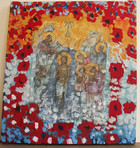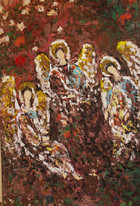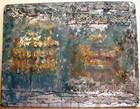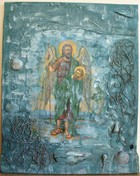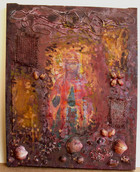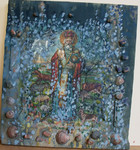The Sisters Kelogregovi
The stereotype of the solitary artist-genius with a unique vision to promote against all rivals has become such a cliché of modern pop culture, we tend to forget that for most of human history art-making was a communal activity. Thank goodness, we have the Kelogregovi sisters of Limassol, Cyprus, to remind us of the way things were!
I discovered their art, family-style, when I showed up at the wrong gallery for the wrong exhibition. I was ready to beat a quick retreat, until I spied these strange icon collages on the far wall. The religious images, themselves, were cheap reproductions, available at any Greek Orthodox book stall. They had been mounted on oddly shaped canvases; decorated with string, seashells, and scraps of cloth; and finished off with splotches of color. Somehow, it all worked.
The appeal of these off-beat sacred art objects probably had a lot to do with the fact that they were the work, not of one artist, but three. The Kelogregovi sisters--Maria, Christina and Anna. Christina and Anna are the professional artists in the family, who studied in France, while elder sister, Maria, followed the traditional path of many Cypriot women of her generation by marrying a restaurant owner and raising five children. This difference in educational opportunity might have led to sibling rivalry in other families, but not the Kelogregovis. When Maria got the notion to make art later in life, Christina and Anna proved her most enthusiastic supporters—and a bit more.
Whenever Maria begins an icon collage, she knows Anna can be counted on to fill in the background with broad strokes of color, while Christina will finish things off with some personal touch like a floral design. Or, maybe, Christina will do the main brush work and leave the final details to Anna. As for the lop-sided canvases, they are the work of the family patriarch, now in his 80s. Despite failing eyesight, Father Kelogregovi insists on cobbling the frames together from odd lots of wood. Whoever does what, when, and how in this unique artistic process, the work can truly be called a labor of love.
